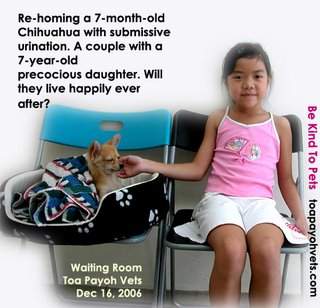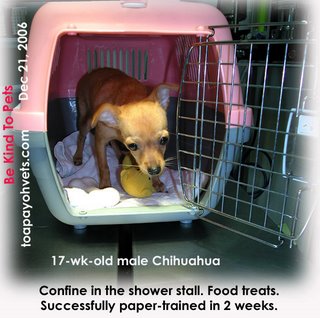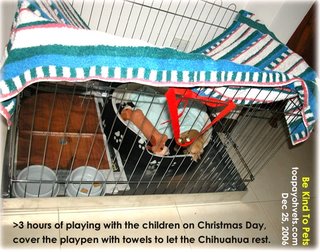Saturday, Dec 16, 2006
Rachel, the 7-year-old girl could not sleep when her mum told her she would be getting a puppy on Saturday. Kopi, the 7-month-old male Chihuahua could not stop trembling when he met Rachel and her parents. I was the one getting Kopi a new home but I was on leave this Saturday and would not be at the Veterinary Surgery.
I had known Kopi when he was a 2-month-old. He used to bark for attention when kept in a crate. After many minutes of barking and no attention, he behaved. Anna took him home as the Surgery was not considered a healthy place for him as he had only one vaccination. 3 vaccinations would be necessary. He was paper-trained for peeing but he would poop on the toilet floor. "When he is frightened or excited, he pees," Anna said. So, this was a case of submissive urination in a male Chihuahua. To him, all people look gigantic.
I knew Rachel is a precocious girl from the illustrations and writings of her mother and her uncle's dalmatian dog care. I doubt many 7-year-old can do that. So, I think she's precocious. When we met at the Veterinary Surgery and on the way to the pet shop at Thomson Road, she would converse with me on many topics. Non-stop. Like chatterboxes.
"Is the injection (vaccination) of the puppy painful? Look, I had an injection on my right hand. Just a pin prick.
"The teacher said that girls who cried during injection would not get 2 sweets but must stay in the class room.
I asked her mother not to interrupt as I wanted to know whether she could care for Kopi.
"So, did you get 2 sweets?" I expected her to be brave.
"Yes."
I assessed that she could take care of the dog although she was only 7 years old and in Primary one. Music lessons. Ballet lessons. She could cope. The grandmother could help. The working parents were first-time dog owners.
So, I had to go back to the Surgery to brief them on how to manage this dog. So that the dog would not be returned. And get a good home. Here are the steps to be put in
writing as people do forget:
1.
Know where the dog should stay inside the apartment. The balcony was out as it was windy. Mum decided on getting the playpen with the Aluminium pee tray. That was expensive but her floor tiles would not be stained with urine.
2.
A bed. Kopi used to sleep on a towel. But Rachel had bought a soft bed with towels the day before. That would be great.
3.
Food. Exactly the same brand of premium puppy food. Amount would be what Anna had been feeding. Breakfast and dinner times told to her.
4.
Water bowl. 5.
Peeing and pooping. Would be on newspapers before taking the dog out. Keep the dog inside the crate for the first 7 days until he is used to the routine. Take out only after he poops and pees. Will this be possible?
6. Exercise. Play during certain times when Rachel is not studying. The pet shop recommended a thin leash and collar meant for Chihuahuas and toy breeds. Mum nearly bought the wrong big collars and leash.
7.
Sleeping time. Kopi usually sleeps in the afternoon and late at night.
8.
Bathing. Once a week.

9.
Permissive Urination. I forgot about this topic. Will e-mail the advices to the mum.
9.1 Do not shout, pat his head or bend over to talk to him. Talk to him in a soft voice. No spanking or negative reinforcement training experiences. He may get frightened and just pee in submission.
9.2 Do not let visitors or anyone pat his head. Rachel can pet him on the chin.
9.3 Obedience Training. Reward him with food treats and lavish praises when doing "obedience training" like SIT.
9.4 Socialising with other dogs. Take this step slowly. Go to dog parks but do not force him to meet other dogs or strangers.
I would have to follow up to make sure there is a happy ending for Kopi. It is not good for a dog to be rehomed more than once. Hence a written dog care guideline is most important for the new owner, sharing experiences with the ex-owner.
Following up on Day 3. In Blog 33, Kopi was re-homed and the following happened:
1.
Elimination routine upset. Everybody plays with him, including the husband and the Filipino maid.
2.
Barking a lot for attention. He wanted attention and knew that the maid would come when he barks.
3.
Poops outside the crate. Poops on the dining area and below the dining table at night. The mother scolded him, put him back to the crate and told him to poop onto the newspapers covering half the floor of the crate. He tried to eat the stools.
However, on day 2, he pooped inside the crate. This could be due to confinement rather than his intelligence. Wait and see.
4.
Hair dryer after bathing by the mum. The Chihuahua was trembling for a long time. He is frightened of the noise. He did not suffer from submissive urination. He is a timid dog.
5.
"Chihuahua likes to bite children". The mother heard this myth from others. It is not correct. With proper training, almost all dogs will not bite children.
6. Today is Monday.
Must establish a routine. Rachel feels that the dog is not so close to her. This is because the maid keeps paying attention to him. Need to confine the dog for one week at least to get the routine set. Can bring him downstairs to exercise at certain times. Bring newspapers with urine+poop smell and leash him.

In the morning, the maid is busy preparing breakfast.
So, it is best to confine the chihuahua inside the crate and not let the maid play with him. He needs to have as structured life. Ignore his barking. Otherwise it will be hard for him.
7. I don't know whether Kopi would be returned back. Much depends on follow up and advices. Once his toilet training habits are good, he should be able to roam around the apartment freely. He needs a structured life. A routine. A time-table. Strong pack leadership from the family but the pack leader (Rachel's mum is at work)!
DAY 4
A success story---Kiki
Dec 20, 2006Surprisingly, the owner of Kiki, a brown male chihuahua, 17 weeks old, asked about Rachel's chihuahua Kopi whom she saw at the Veterinary Surgery sometime ago.
"Kopi is in a new home for the last 3 days," I said sadly.
I was thinking of the chihuhaua Kopi who might be returned back to the Surgery if he continued to bark a lot and therefore a noise nuisance.
Barking for attention is like
throwing tantrums in 3-year-old children. I told Rachel's mum to totally ignore Kopi's barking on the first day at the new home. The maid and the grandmother ignored this advice.
So Kopi knew that the maid or the aged grandmother would come to see him if he barked long enough. This is known as a negative reinforcement training?
Just like a 3-year-old I met at Thomson Medical Hospital visiting somebody who had a newborn baby. Her 3-year-old niece just had to open her mouth to cry. The aunty would quickly give in to what she wanted. No need further action.
If Kopi was ignored on the first day, he would not bark anymore. But the maid was attentive to him. The grandmother would see him.
It was also important that Kopi be given a routine of feeding and exercise so that he could be
properly toilet trained. That meant crating him up for most of the time
for the next 7 days. However, too many visitors and play distracted him.
So he pooped outside the crate, under the dining table and on the tiled marble floor. Or pooped many times as he held back wanting to play. In the end, he would be returned to Anna through no fault of his own.
He is home alone most of the time. My veterinary assistant, Anna has to work. Kopi is better off with a family with more people. Kopi is a social dog. He just loved company.
Back to the Surgery room. I said to Kiki's owner. "Kopi has been given as a present to Rachel, a 7-year-old girl about the age of your daughter. How old is she?"
"Tell the doctor your age," mum said.
The little girl said "I am eight years old." She was not as talkative as Rachel.
I could see that the mum was the pack leader and that was the secret of her success in training Kiki. She trained him continually as Kiki tried to get out of the carrier crate. I had put Kiki on the operating table to take pictures under the operating light.
"I need Kiki to come out of the carrier as there is light for photography," I explained to the mum as she kept commanding Kiki to stay inside the crate.

This mother had time to train the dog.
Rachel's mother was a hardworking career woman. She could give instructions from her office. But she could not be home all day.
Still it was best for Kopi's future that I followed up.
Barking was the main problem. Chihuahuas are said to be loud barkers. But so are many other breeds.
Disruption of his routine by so many visitors was another. Distractions affect his pooping times.
The maid was told to give Kopi a time table of feeding and exercise. Rachel still had not recovered from her fear of dogs. At 3 years old, a big Beagle jumped onto her back. At that age, she became fearful of dogs. So, she was a bit afraid of Kopi even though Kopi should be afraid of her. She was 10 times bigger. To Kopi, she was gigantic.
"How's the toilet training in the flat?" I asked the mother. She has another child to care for. The maid was with her at the Surgery.
"I don't live in a flat," she told me she was residing in a condo. By "flat", I mean an apartment. But I guess it meant different to others. A condo has a swimming pool and other facilities. A flat does not have such facilities? The Speak Good Englishment Movement of Singapore people may need to educate me.
The mum has a very good way of toilet training the puppy.
Toilet location: Shower stall with glass door for 2 weeks. The glass door enabled the chihuahua to see the owners but not to come out for 2 weeks.
Newspapers covered the floor except for the area where the plastic carrier crate is.
Bed: The plastic carrier crate is the den. Soft towels and two chew toys. The door is left open.
On week 3, permitted to go to the kitchen. Restricted area with no urine smell and near the shower stall.
Positive reinforcement training. Food treats given after elimination on newspapers.
By 14 days, this puppy was paper-trained. No need for food treats now. Just poop 1x/day, 5 minutes after eating. Pees 5-6 x per day.
"How often you change the newspapers?" I asked the maid. It was 5-6 times a day. This was about the same as reported by other owners of 5-month-old dogs. But pooping once a day was really exceptional as most do it more than once.
New sleeping area: Kitchen, inside the carrier crate.
It sounded so easy. However, the mother was
a strict teacher who spent time teaching as I could see her pointing fingers for Kiki to go inside the carrier crate while I wanted to take pictures. She was afraid that Kiki might come out and fall down the operating table on which I took pictures. I needed the light as it was a heavy 24-hour raining day today and there was no sunlight. The operating lights would do.
Success comes to those who know what to do and spend the time--- work hard to do it.
DAY 6
December 22, 20063 days before Christmas. Would the re-homed Chihuahua be returned by Rachel's mother? I had to follow up but tried not to be a pest. Rachel's mother said, "Kopi has settled down. He barks very loudly whenever he hears somebody outside the apartment. However he poops on the newspapers inside the playpen."
So far so good. I read a newspaper research article that children strive when given a "structured" life. What is a structured life? It means that a daily routine so that the child does not get upset or surprised, like homeless kids.
A structured life is also necessary for puppies and re-homed dogs. If they have a time-table of what to do daily, they get toilet trained. Submissive dogs become confident and loved.
Disciplining and training of dogs and children seem to have much in common. Would there be similarities in the practice of counseling people and "counseling" dogs with behavioural problems? There may be common principles.















